A Few-Shot Learning Approach for Historical Ciphered Manuscript Recognition
Mohamed Ali Souibgui,
Alicia Fornés,
Yousri Kessentini,
Crina Tudor

Auto-TLDR; Handwritten Ciphers Recognition Using Few-Shot Object Detection
Similar papers
The HisClima Database: Historical Weather Logs for Automatic Transcription and Information Extraction
Verónica Romero, Joan Andreu Sánchez

Auto-TLDR; Automatic Handwritten Text Recognition and Information Extraction from Historical Weather Logs
Abstract Slides Poster Similar
Watch Your Strokes: Improving Handwritten Text Recognition with Deformable Convolutions
Iulian Cojocaru, Silvia Cascianelli, Lorenzo Baraldi, Massimiliano Corsini, Rita Cucchiara

Auto-TLDR; Deformable Convolutional Neural Networks for Handwritten Text Recognition
Abstract Slides Poster Similar
Recursive Recognition of Offline Handwritten Mathematical Expressions
Marco Cotogni, Claudio Cusano, Antonino Nocera

Auto-TLDR; Online Handwritten Mathematical Expression Recognition with Recurrent Neural Network
Abstract Slides Poster Similar
Writer Identification Using Deep Neural Networks: Impact of Patch Size and Number of Patches
Akshay Punjabi, José Ramón Prieto Fontcuberta, Enrique Vidal

Auto-TLDR; Writer Recognition Using Deep Neural Networks for Handwritten Text Images
Abstract Slides Poster Similar
Vision-Based Layout Detection from Scientific Literature Using Recurrent Convolutional Neural Networks

Auto-TLDR; Transfer Learning for Scientific Literature Layout Detection Using Convolutional Neural Networks
Abstract Slides Poster Similar
Improving Word Recognition Using Multiple Hypotheses and Deep Embeddings
Siddhant Bansal, Praveen Krishnan, C. V. Jawahar

Auto-TLDR; EmbedNet: fuse recognition-based and recognition-free approaches for word recognition using learning-based methods
Abstract Slides Poster Similar
The DeepScoresV2 Dataset and Benchmark for Music Object Detection
Lukas Tuggener, Yvan Putra Satyawan, Alexander Pacha, Jürgen Schmidhuber, Thilo Stadelmann
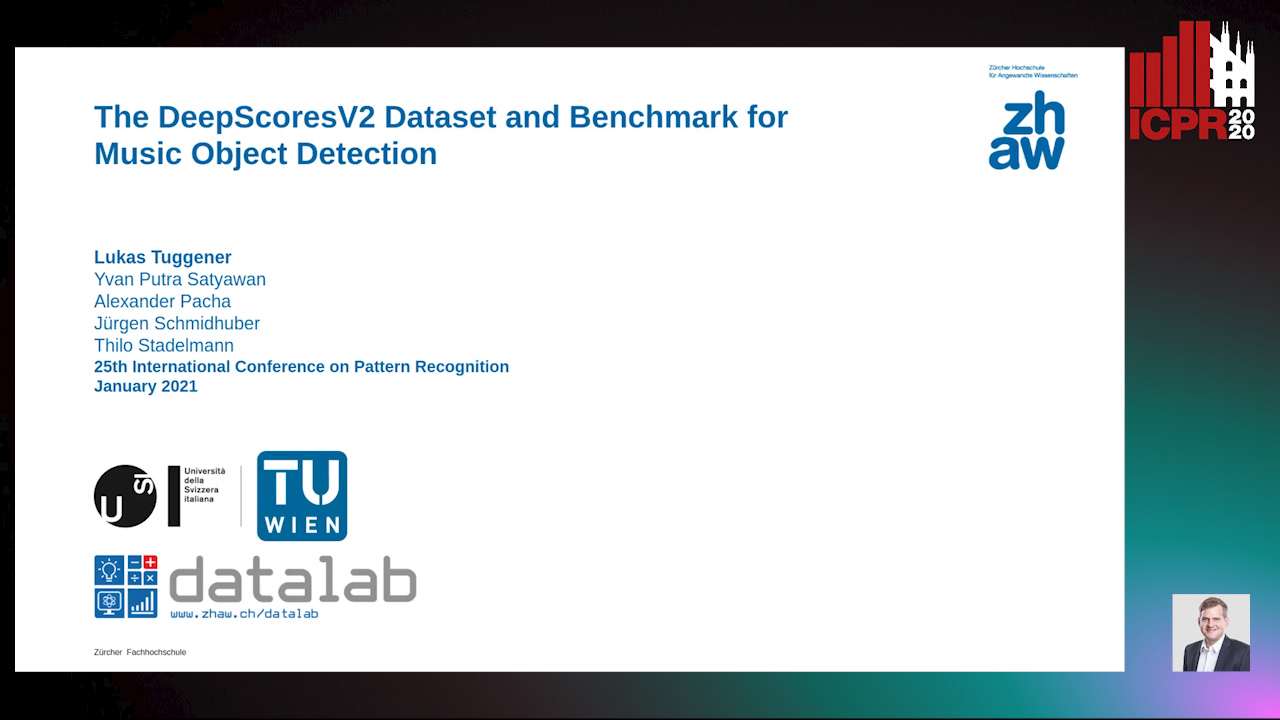
Auto-TLDR; DeepScoresV2: an extended version of the DeepScores dataset for optical music recognition
Abstract Slides Poster Similar
Textual-Content Based Classification of Bundles of Untranscribed of Manuscript Images
José Ramón Prieto Fontcuberta, Enrique Vidal, Vicente Bosch, Carlos Alonso, Carmen Orcero, Lourdes Márquez

Auto-TLDR; Probabilistic Indexing for Text-based Classification of Manuscripts
Abstract Slides Poster Similar
Recognizing Bengali Word Images - A Zero-Shot Learning Perspective
Sukalpa Chanda, Daniël Arjen Willem Haitink, Prashant Kumar Prasad, Jochem Baas, Umapada Pal, Lambert Schomaker

Auto-TLDR; Zero-Shot Learning for Word Recognition in Bengali Script
Abstract Slides Poster Similar
Online Trajectory Recovery from Offline Handwritten Japanese Kanji Characters of Multiple Strokes
Hung Tuan Nguyen, Tsubasa Nakamura, Cuong Tuan Nguyen, Masaki Nakagawa
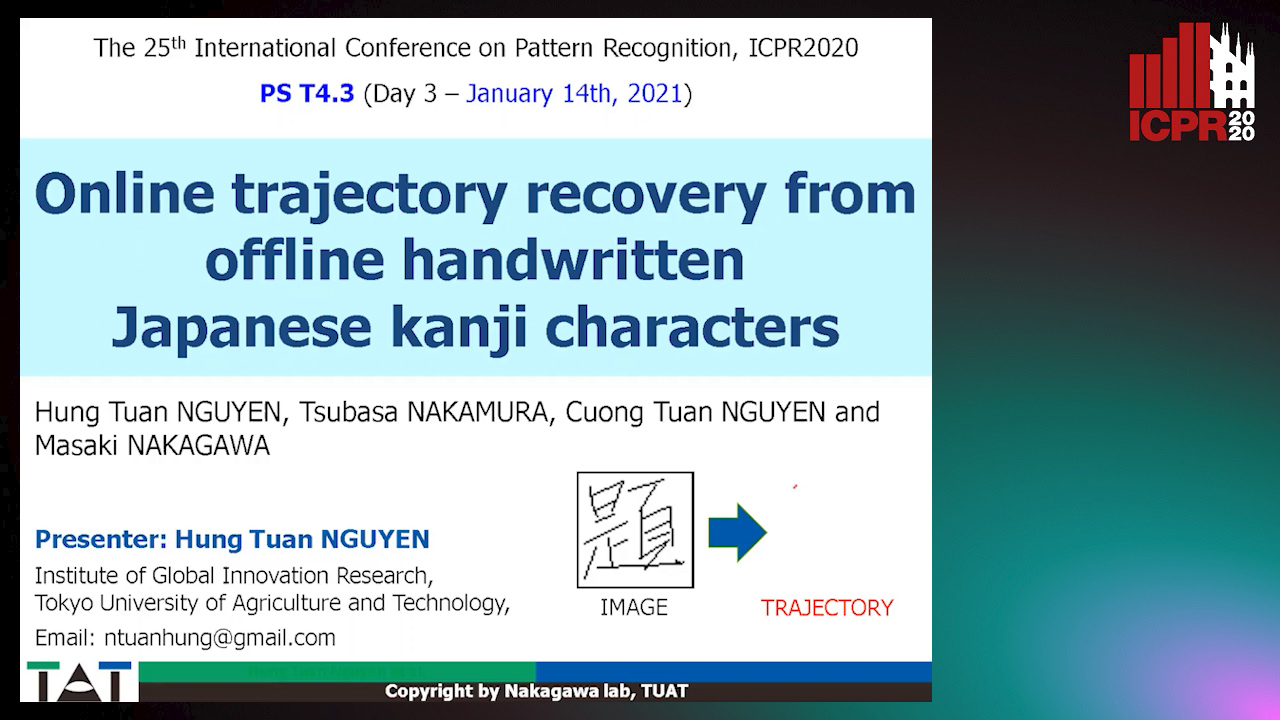
Auto-TLDR; Recovering Dynamic Online Trajectories from Offline Japanese Kanji Character Images for Handwritten Character Recognition
Abstract Slides Poster Similar
Text Baseline Recognition Using a Recurrent Convolutional Neural Network
Matthias Wödlinger, Robert Sablatnig
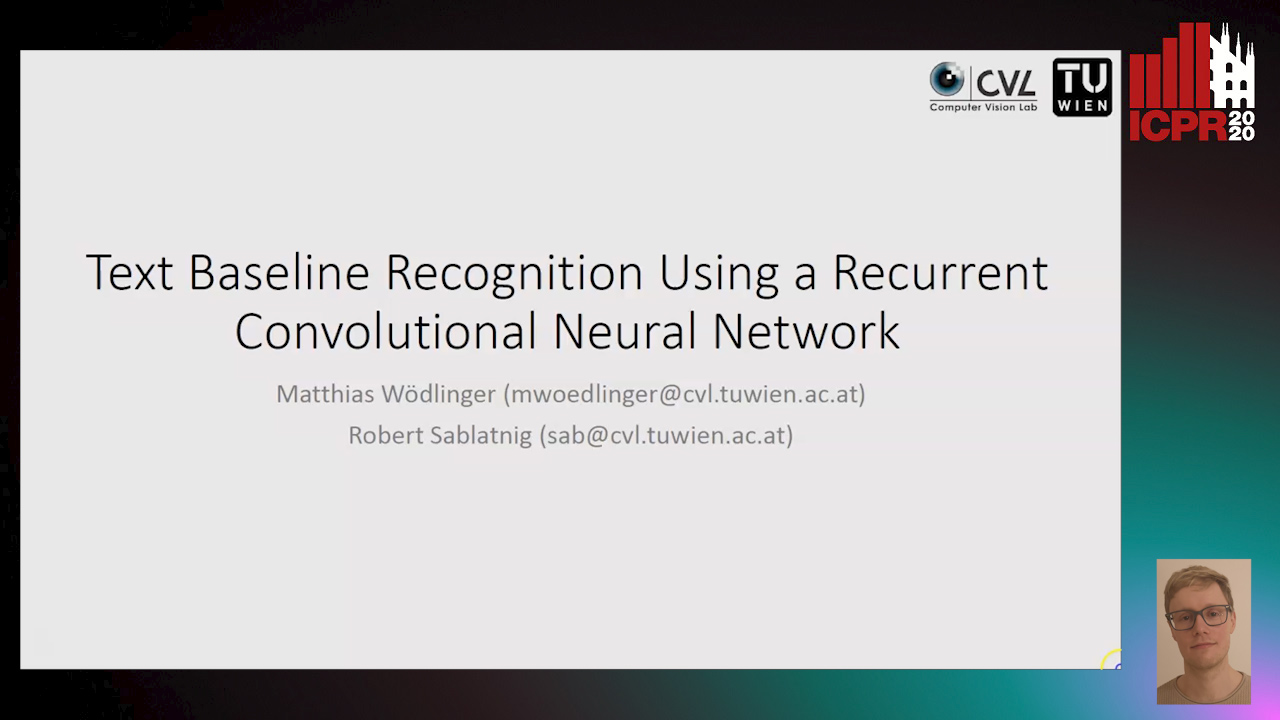
Auto-TLDR; Automatic Baseline Detection of Handwritten Text Using Recurrent Convolutional Neural Network
Abstract Slides Poster Similar
A Fast and Accurate Object Detector for Handwritten Digit String Recognition
Jun Guo, Wenjing Wei, Yifeng Ma, Cong Peng

Auto-TLDR; ChipNet: An anchor-free object detector for handwritten digit string recognition
Abstract Slides Poster Similar
Text Recognition - Real World Data and Where to Find Them
Klára Janoušková, Lluis Gomez, Dimosthenis Karatzas, Jiri Matas

Auto-TLDR; Exploiting Weakly Annotated Images for Text Extraction
Abstract Slides Poster Similar
Learning to Sort Handwritten Text Lines in Reading Order through Estimated Binary Order Relations
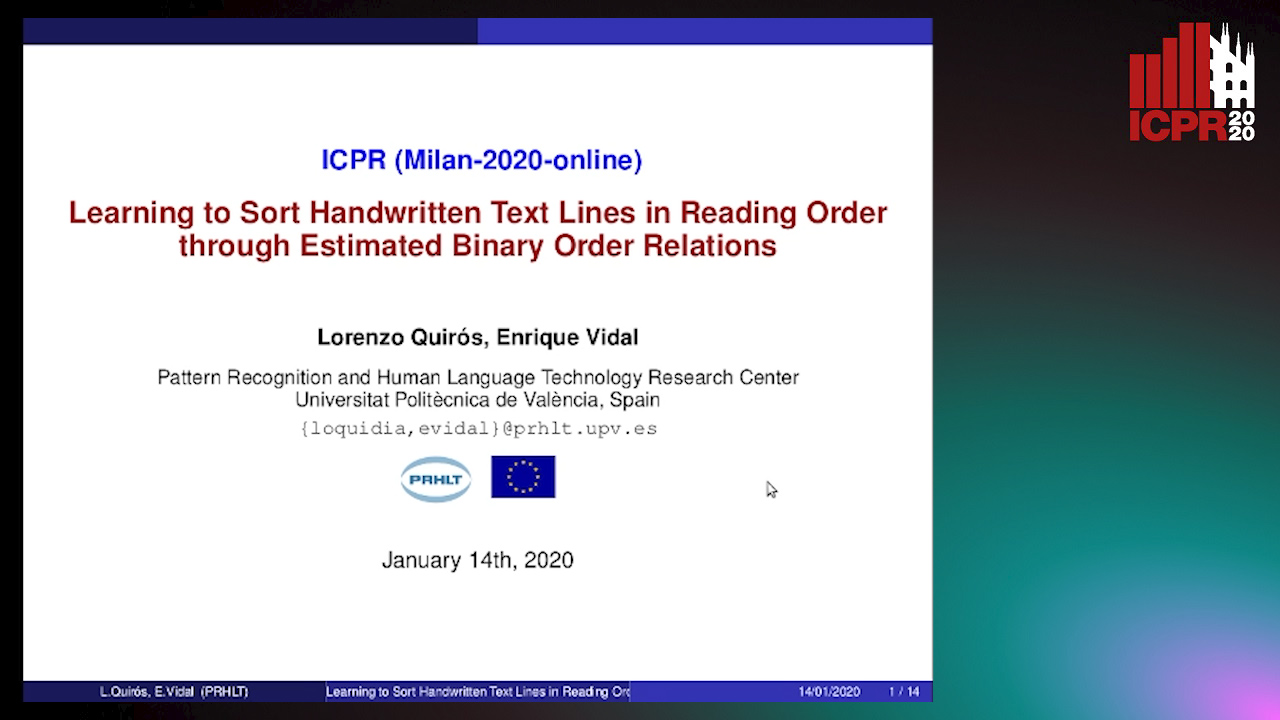
Auto-TLDR; Automatic Reading Order of Text Lines in Handwritten Text Documents
Multiple Document Datasets Pre-Training Improves Text Line Detection with Deep Neural Networks
Mélodie Boillet, Christopher Kermorvant, Thierry Paquet

Auto-TLDR; A fully convolutional network for document layout analysis
LODENet: A Holistic Approach to Offline Handwritten Chinese and Japanese Text Line Recognition
Huu Tin Hoang, Chun-Jen Peng, Hung Tran, Hung Le, Huy Hoang Nguyen
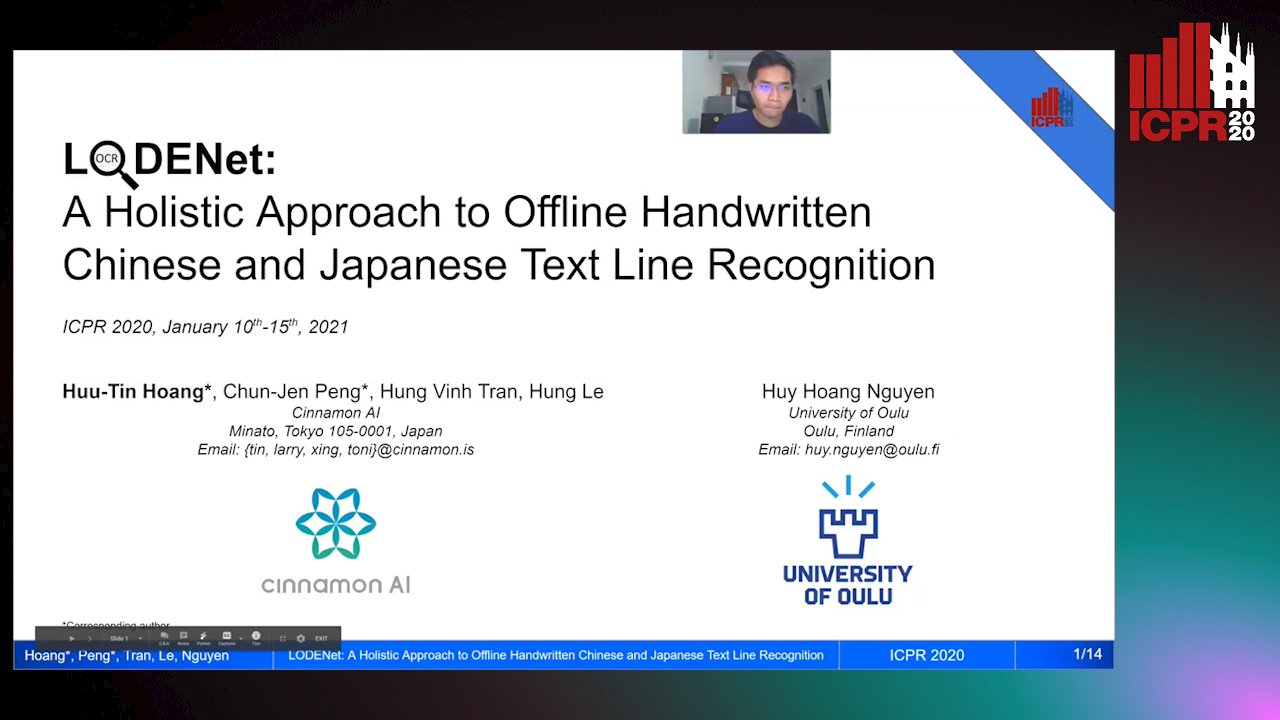
Auto-TLDR; Logographic DEComposition Encoding for Chinese and Japanese Text Line Recognition
Abstract Slides Poster Similar
An Integrated Approach of Deep Learning and Symbolic Analysis for Digital PDF Table Extraction
Mengshi Zhang, Daniel Perelman, Vu Le, Sumit Gulwani

Auto-TLDR; Deep Learning and Symbolic Reasoning for Unstructured PDF Table Extraction
Abstract Slides Poster Similar
Unsupervised deep learning for text line segmentation
Berat Kurar Barakat, Ahmad Droby, Reem Alaasam, Borak Madi, Irina Rabaev, Raed Shammes, Jihad El-Sana
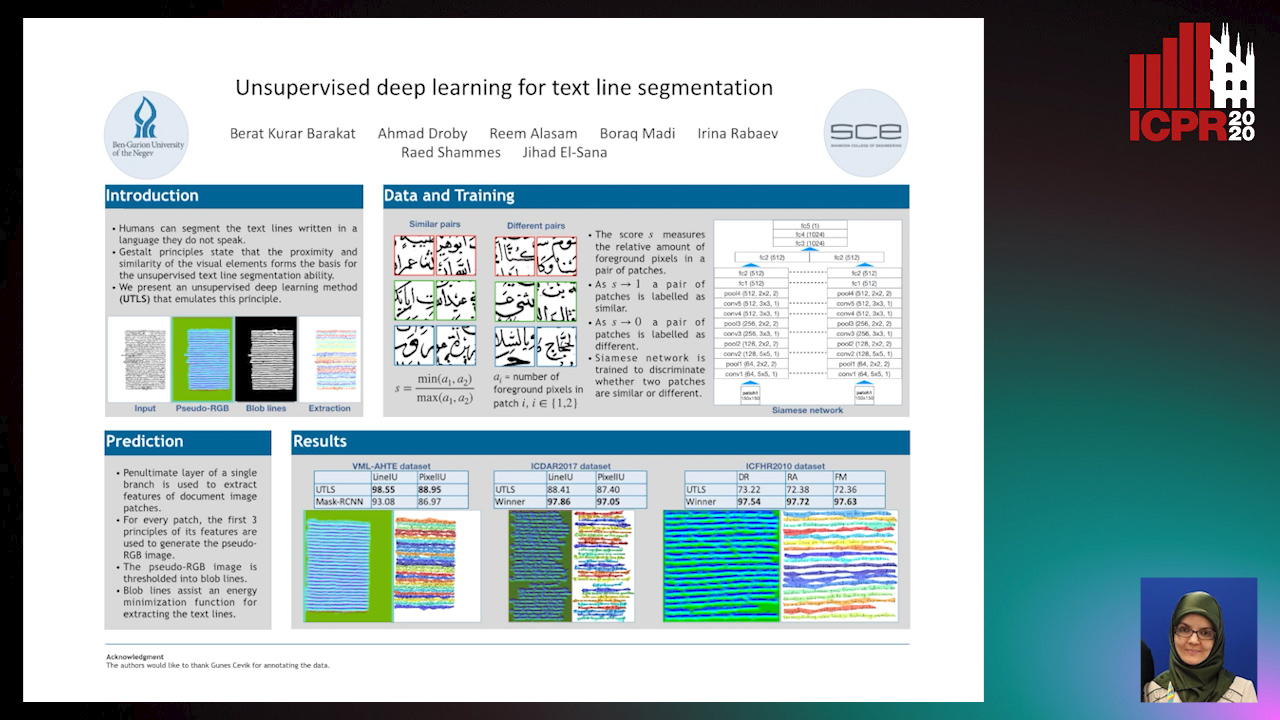
Auto-TLDR; Unsupervised Deep Learning for Handwritten Text Line Segmentation without Annotation
Enhancing Handwritten Text Recognition with N-Gram Sequencedecomposition and Multitask Learning
Vasiliki Tassopoulou, George Retsinas, Petros Maragos

Auto-TLDR; Multi-task Learning for Handwritten Text Recognition
Abstract Slides Poster Similar
ConvMath : A Convolutional Sequence Network for Mathematical Expression Recognition
Zuoyu Yan, Xiaode Zhang, Liangcai Gao, Ke Yuan, Zhi Tang

Auto-TLDR; Convolutional Sequence Modeling for Mathematical Expressions Recognition
Abstract Slides Poster Similar
Ancient Document Layout Analysis: Autoencoders Meet Sparse Coding
Homa Davoudi, Marco Fiorucci, Arianna Traviglia

Auto-TLDR; Unsupervised Unsupervised Representation Learning for Document Layout Analysis
Abstract Slides Poster Similar
ID Documents Matching and Localization with Multi-Hypothesis Constraints
Guillaume Chiron, Nabil Ghanmi, Ahmad Montaser Awal

Auto-TLDR; Identity Document Localization in the Wild Using Multi-hypothesis Exploration
Abstract Slides Poster Similar
Multimodal Side-Tuning for Document Classification
Stefano Zingaro, Giuseppe Lisanti, Maurizio Gabbrielli

Auto-TLDR; Side-tuning for Multimodal Document Classification
Abstract Slides Poster Similar
A Transformer-Based Radical Analysis Network for Chinese Character Recognition
Chen Yang, Qing Wang, Jun Du, Jianshu Zhang, Changjie Wu, Jiaming Wang
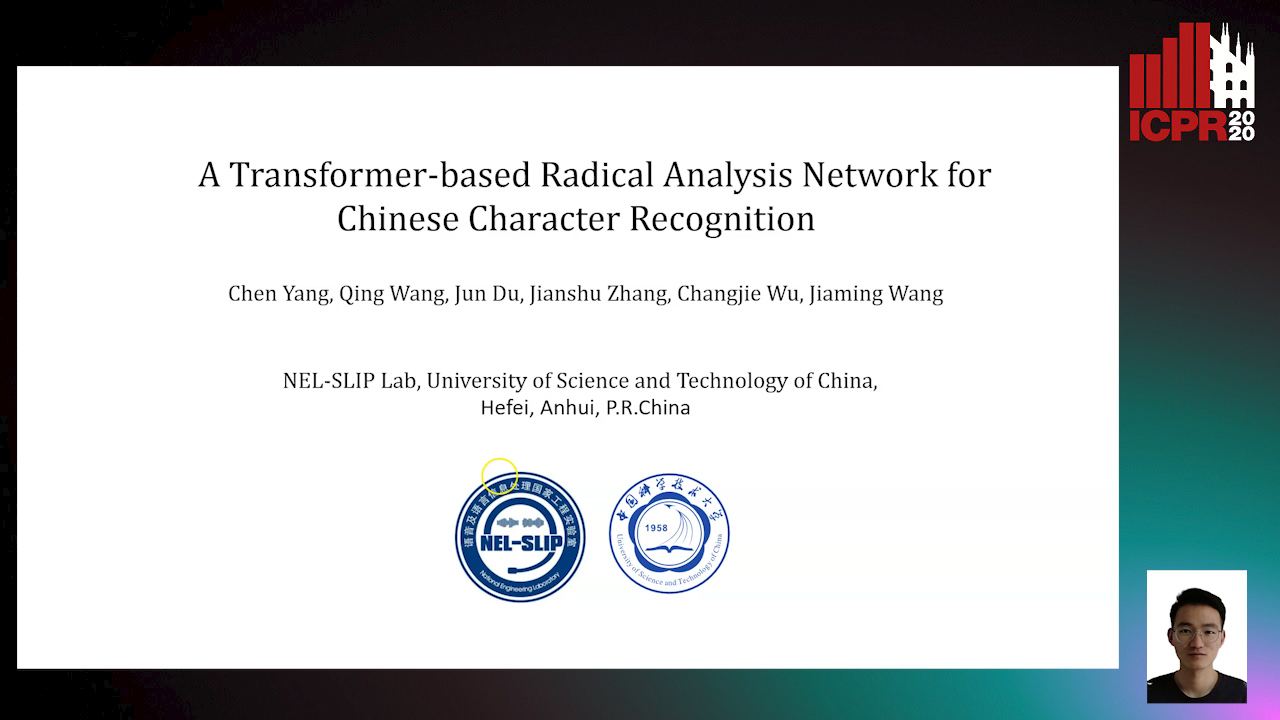
Auto-TLDR; Transformer-based Radical Analysis Network for Chinese Character Recognition
Abstract Slides Poster Similar
Recognizing Multiple Text Sequences from an Image by Pure End-To-End Learning
Zhenlong Xu, Shuigeng Zhou, Fan Bai, Cheng Zhanzhan, Yi Niu, Shiliang Pu
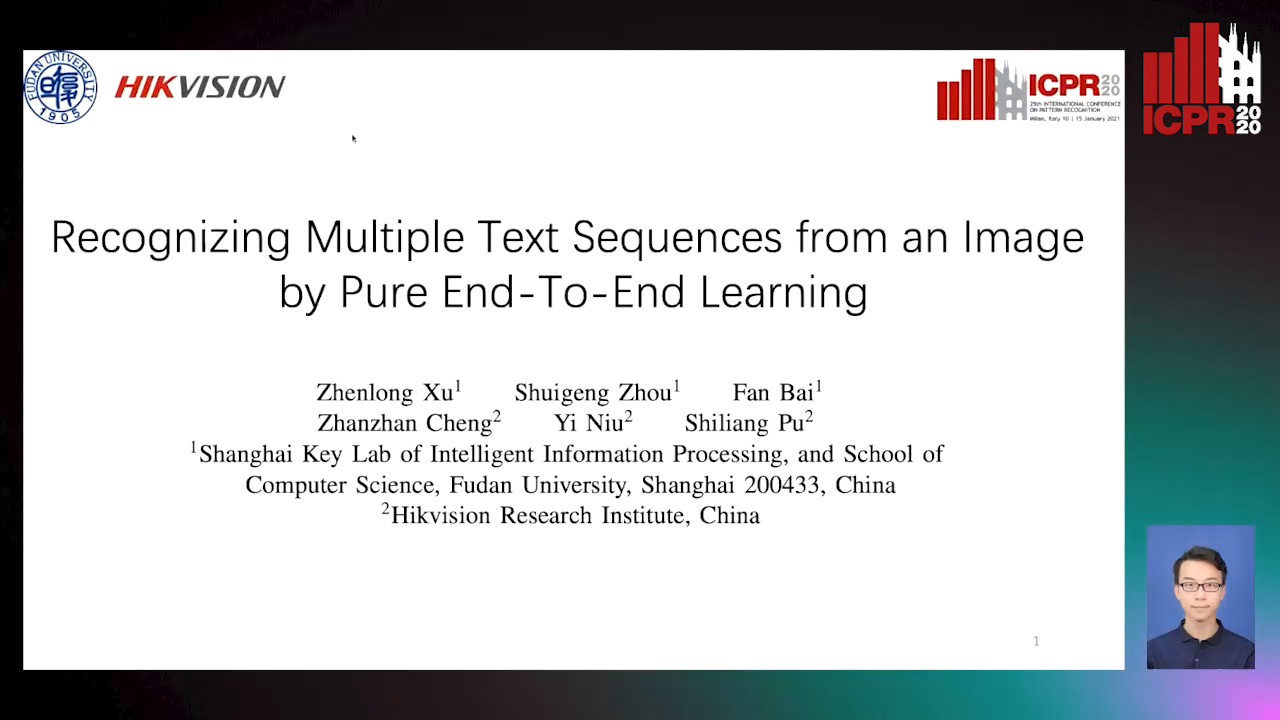
Auto-TLDR; Pure End-to-End Learning for Multiple Text Sequences Recognition from Images
Abstract Slides Poster Similar
DUET: Detection Utilizing Enhancement for Text in Scanned or Captured Documents
Eun-Soo Jung, Hyeonggwan Son, Kyusam Oh, Yongkeun Yun, Soonhwan Kwon, Min Soo Kim
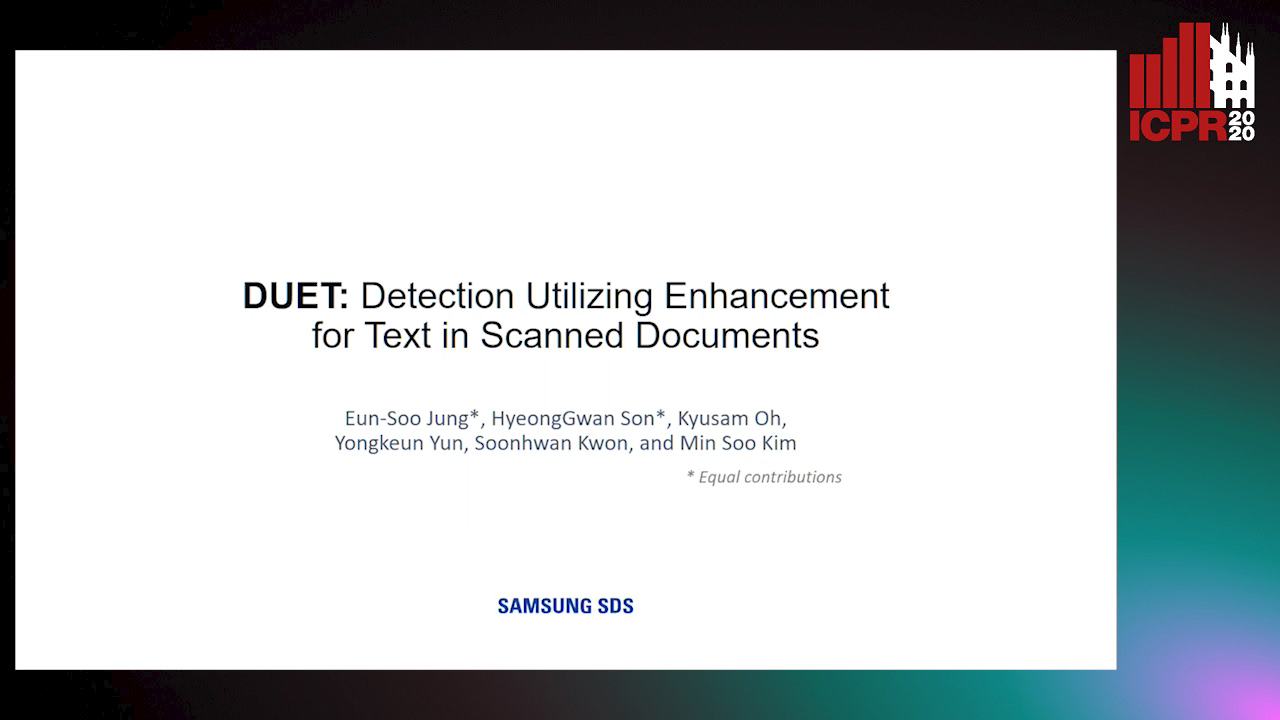
Auto-TLDR; Text Detection for Document Images Using Synthetic and Real Data
Abstract Slides Poster Similar
Automated Whiteboard Lecture Video Summarization by Content Region Detection and Representation
Bhargava Urala Kota, Alexander Stone, Kenny Davila, Srirangaraj Setlur, Venu Govindaraju

Auto-TLDR; A Framework for Summarizing Whiteboard Lecture Videos Using Feature Representations of Handwritten Content Regions
Combining Deep and Ad-Hoc Solutions to Localize Text Lines in Ancient Arabic Document Images
Olfa Mechi, Maroua Mehri, Rolf Ingold, Najoua Essoukri Ben Amara

Auto-TLDR; Text Line Localization in Ancient Handwritten Arabic Document Images using U-Net and Topological Structural Analysis
Abstract Slides Poster Similar
CDeC-Net: Composite Deformable Cascade Network for Table Detection in Document Images
Madhav Agarwal, Ajoy Mondal, C. V. Jawahar

Auto-TLDR; CDeC-Net: An End-to-End Trainable Deep Network for Detecting Tables in Document Images
An Evaluation of DNN Architectures for Page Segmentation of Historical Newspapers
Manuel Burghardt, Bernhard Liebl

Auto-TLDR; Evaluation of Backbone Architectures for Optical Character Segmentation of Historical Documents
Abstract Slides Poster Similar
A Multi-Head Self-Relation Network for Scene Text Recognition
Zhou Junwei, Hongchao Gao, Jiao Dai, Dongqin Liu, Jizhong Han

Auto-TLDR; Multi-head Self-relation Network for Scene Text Recognition
Abstract Slides Poster Similar
Named Entity Recognition and Relation Extraction with Graph Neural Networks in Semi Structured Documents
Manuel Carbonell, Pau Riba, Mauricio Villegas, Alicia Fornés, Josep Llados

Auto-TLDR; Graph Neural Network for Entity Recognition and Relation Extraction in Semi-Structured Documents
Image-Based Table Cell Detection: A New Dataset and an Improved Detection Method
Dafeng Wei, Hongtao Lu, Yi Zhou, Kai Chen

Auto-TLDR; TableCell: A Semi-supervised Dataset for Table-wise Detection and Recognition
Abstract Slides Poster Similar
ReADS: A Rectified Attentional Double Supervised Network for Scene Text Recognition
Qi Song, Qianyi Jiang, Xiaolin Wei, Nan Li, Rui Zhang

Auto-TLDR; ReADS: Rectified Attentional Double Supervised Network for General Scene Text Recognition
Abstract Slides Poster Similar
TGCRBNW: A Dataset for Runner Bib Number Detection (and Recognition) in the Wild
Pablo Hernández-Carrascosa, Adrian Penate-Sanchez, Javier Lorenzo, David Freire Obregón, Modesto Castrillon

Auto-TLDR; Racing Bib Number Detection and Recognition in the Wild Using Faster R-CNN
Abstract Slides Poster Similar
2D License Plate Recognition based on Automatic Perspective Rectification
Hui Xu, Zhao-Hong Guo, Da-Han Wang, Xiang-Dong Zhou, Yu Shi

Auto-TLDR; Perspective Rectification Network for License Plate Recognition
Abstract Slides Poster Similar
Robust Lexicon-Free Confidence Prediction for Text Recognition
Qi Song, Qianyi Jiang, Rui Zhang, Xiaolin Wei

Auto-TLDR; Confidence Measurement for Optical Character Recognition using Single-Input Multi-Output Network
Abstract Slides Poster Similar
Scene Text Detection with Selected Anchors
Anna Zhu, Hang Du, Shengwu Xiong

Auto-TLDR; AS-RPN: Anchor Selection-based Region Proposal Network for Scene Text Detection
Abstract Slides Poster Similar
Text Recognition in Real Scenarios with a Few Labeled Samples
Jinghuang Lin, Cheng Zhanzhan, Fan Bai, Yi Niu, Shiliang Pu, Shuigeng Zhou

Auto-TLDR; Few-shot Adversarial Sequence Domain Adaptation for Scene Text Recognition
Abstract Slides Poster Similar
Cross-Lingual Text Image Recognition Via Multi-Task Sequence to Sequence Learning
Zhuo Chen, Fei Yin, Xu-Yao Zhang, Qing Yang, Cheng-Lin Liu

Auto-TLDR; Cross-Lingual Text Image Recognition with Multi-task Learning
Abstract Slides Poster Similar
Multi-Task Learning Based Traditional Mongolian Words Recognition
Hongxi Wei, Hui Zhang, Jing Zhang, Kexin Liu

Auto-TLDR; Multi-task Learning for Mongolian Words Recognition
Abstract Slides Poster Similar
Stroke Based Posterior Attention for Online Handwritten Mathematical Expression Recognition
Changjie Wu, Qing Wang, Jianshu Zhang, Jun Du, Jiaming Wang, Jiajia Wu, Jin-Shui Hu

Auto-TLDR; Posterior Attention for Online Handwritten Mathematical Expression Recognition
Abstract Slides Poster Similar
Cross-People Mobile-Phone Based Airwriting Character Recognition
Yunzhe Li, Hui Zheng, He Zhu, Haojun Ai, Xiaowei Dong

Auto-TLDR; Cross-People Airwriting Recognition via Motion Sensor Signal via Deep Neural Network
Abstract Slides Poster Similar
Segmenting Messy Text: Detecting Boundaries in Text Derived from Historical Newspaper Images

Auto-TLDR; Text Segmentation of Marriage Announcements Using Deep Learning-based Models
Abstract Slides Poster Similar
Detecting Objects with High Object Region Percentage
Fen Fang, Qianli Xu, Liyuan Li, Ying Gu, Joo-Hwee Lim

Auto-TLDR; Faster R-CNN for High-ORP Object Detection
Abstract Slides Poster Similar
Large-Scale Historical Watermark Recognition: Dataset and a New Consistency-Based Approach
Xi Shen, Ilaria Pastrolin, Oumayma Bounou, Spyros Gidaris, Marc Smith, Olivier Poncet, Mathieu Aubry

Auto-TLDR; Historical Watermark Recognition with Fine-Grained Cross-Domain One-Shot Instance Recognition
Abstract Slides Poster Similar
Feature Embedding Based Text Instance Grouping for Largely Spaced and Occluded Text Detection
Pan Gao, Qi Wan, Renwu Gao, Linlin Shen

Auto-TLDR; Text Instance Embedding Based Feature Embeddings for Multiple Text Instance Grouping
Abstract Slides Poster Similar
Iterative Bounding Box Annotation for Object Detection
Bishwo Adhikari, Heikki Juhani Huttunen

Auto-TLDR; Semi-Automatic Bounding Box Annotation for Object Detection in Digital Images
Abstract Slides Poster Similar